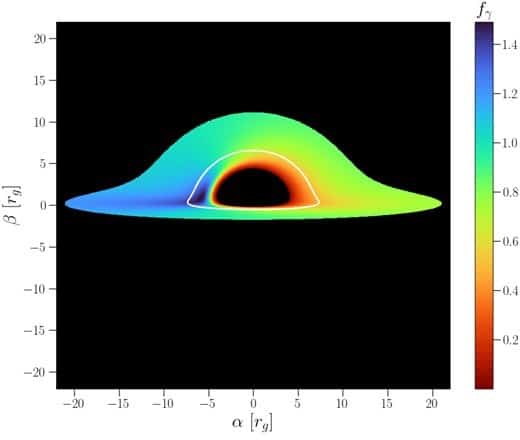[ad_1]
Astronomers observed the “diving area” for the first time black hole, the region where matter stops rotating and dives directly toward its center, like a waterfall. Predicted by Einstein’s general theory of relativity, this is the inner boundary of the accretion disk, just before the event horizon. Contrary to previous hypotheses, this area continues to emit radiation, which enabled its detection.
When an object or matter is near a black hole, it is attracted by the black hole’s gravitational force and ends up disintegrating at its edge, thus feeding the high-energy accretion disk, before reaching the event horizon (the point of no return, where nothing, not even light, can avoid the black hole’s gravitational attraction).
According to Newton’s theory of gravity, matter should continue to orbit the black hole until it encounters the event horizon.
However, Einstein predicted that at distances close enough to the event horizon—a region called the “diving region”—it becomes impossible for particles to maintain circular orbits. They then begin to rapidly fall towards the center of the black hole at a speed close to the speed of light.
As an analogy, the accretion disk is comparable to a river leading to a waterfall: a diving area. ”
If Einstein was wrong, then everything would be stable until the end – there would be only one river “, he explains to A new scientist Andrew Mummery of the University of Oxford.
On the other hand, there is a long-standing debate about whether the diving area emits radiation or not, due to its proximity to the event horizon. In the first case, the area would be detectable with our telescopes, while it would be invisible in the second case.
” Previously, we somehow thought that anything that crossed that limit would not have time to radiate meaningfully before plunging into a black hole. says Greg Salvesen of Los Alamos National Laboratory in New Mexico. As a result, most modeling omits potential radiative emissions from the innermost stable circular orbit of the accretion disk (ie, the outer limit where the circular orbit of the particles has not yet been perturbed).
A study by Mummery and his colleagues concludes the debate by revealing the first observational evidence of a black hole diving region. ” Einstein’s theory suggests that this final fall exists, but this is the first time we have been able to show that this is indeed the case.” Indicates the expert communicated from the University of Oxford. ” So far we have looked at the river, and this is our first view of the waterfall “, he adds.
Unexpected additional impact
As part of their research – detailed in Monthly Notices of the Royal Astronomical Society — the research team focused on a small black hole in a binary called MAXI J1820+070 located at 10,000 light years countries.
To do this, they relied on data from NASA’s Nuclear Spectroscopic Telescope Array (NuSTAR) and Neutron Star Interior Composition ExploreR (NICER) X-ray space telescopes to analyze their light spectrum. The data was then used to run simulations of how the material moves towards its sinking zone.
Observational data showed that the black hole emitted slightly more radiation than would be expected from its accretion disk. This brightness corresponds to simulations including additional radiation from the diving region.
According to experts, this is the first look at how plasma from a black hole’s accretion disk stops spinning and cascades toward the center.

These results provide valuable information on one of the most mysterious aspects Black holes and thus could extract new clues about the nature of gravity and space-time. In addition, additional radiation emanating from the diving region would potentially explain the rotational velocity anomalies detected in some black holes. While their rotation is directly correlated with their luminosity, the latter show velocities higher than the theoretical limit.
Furthermore, “what’s really exciting is that there are many black holes in the galaxy and that we now have a reliable new technique to use them to study the strongest gravitational fields known to date,” suggests Mummery.
Later this year, the Oxford team plans to explore this avenue by studying larger, more distant black holes as part of the African Millimeter Telescope project. The latter consists of the use of a new high-performance telescope, which should allow imaging the direct surroundings of black holes.
source: Monthly notices of the Royal Astronomical
[ad_2]
